The best part of reading lesbian pulp fiction is the tone, and the worst part is that everyone turns out straight, because the publishers had to get the books past censors somehow and the best way to do that was to portray the girls who went gay as either a. going back to boys in the end, b. drowning in their own misery or c. actually drowning or dying in some other way that was supposed to be cleansing/cathartic for everyone else in the cast, but especially the dudes and straight ladies who might have felt threatened by the bout of alternative lifestyle going around.
Titles not on this list include Her Raging Needs, Mama Dyke, Governed by Lust, Madame Butch, Another Kind of Love, In the Shadows, These Curious Pleasures, The Third Street, Her Lesbian Half, 21 Gay Street, Maid Service, Babes Behind Bars, Suburban Sexpots, Bisexual Beds, Midnight Orgy, Return to Lesbos, and The Beds of Lesbos. And those are just the ones I could find in five minutes on the Internet.
Women’s Barracks, by Tereska Torres (1950)
Women’s Barracks was published in 1950 and was the very first pulp with lesbians. It was also a fictionalized version of Torres’ own military history in WWII and was marketed as “the frank autobiography of a French girl soldier.” Also: the original cover featured partially naked girls in bustiers.
As a novel, completely separate from any of its historical or lesbian-pulp-fictional significance, Women’s Barracks falls on the rougher end of the five star spectrum. The first person narration is a little too Carrie Bradshaw voiceoveresque, and there is very little actual action, either of the plot-moving kind or the in-your-pants kind. But it was still one of the very first lesbian pulps, and what it says about the genre is far more interesting than what it says about military non-scandal.
Spring Fire, by Vin Packer (1953)
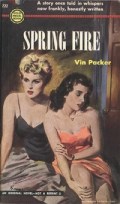 Spring Fire is widely recognized as the first real lesbian pulp fiction book, which basically just means it’s smuttier than Women’s Barracks (and also: was the first original paperback with all-lesbian content). It was only re-released in 2004 because the author (whose real name is Marijane Meaker) didn’t like the very tragic ending she was forced to give it — because the book had to be sent in the mail, positive portrayals of gay lifestyles would mean it wouldn’t pass the censors — and withheld the rights for years.
Spring Fire is widely recognized as the first real lesbian pulp fiction book, which basically just means it’s smuttier than Women’s Barracks (and also: was the first original paperback with all-lesbian content). It was only re-released in 2004 because the author (whose real name is Marijane Meaker) didn’t like the very tragic ending she was forced to give it — because the book had to be sent in the mail, positive portrayals of gay lifestyles would mean it wouldn’t pass the censors — and withheld the rights for years.
The story is based on Meaker’s actual experience. Mitch, whose main personality trait is “awkward,” is in her first year of college and meets Leda, a girl in her sorority who she becomes roommates with. They have an affair, and it does not end well.
Odd Girl Out, by Ann Bannon (1957)
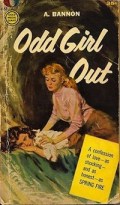 Laura is just starting university when she meets Beth, who is outgoing, attractive, and in a sorority, which she convinces Laura to join. Here’s a hint about how this will end: Bannon was heavily influenced by Meaker, who she wrote to when she was trying to get published. And altering content so it could get through the post was very much still a thing.
Laura is just starting university when she meets Beth, who is outgoing, attractive, and in a sorority, which she convinces Laura to join. Here’s a hint about how this will end: Bannon was heavily influenced by Meaker, who she wrote to when she was trying to get published. And altering content so it could get through the post was very much still a thing.
The predecessor to I Am a Woman (and several of Bannon’s other novels), this novel introduces Laura and chronicles the love affair that drives her from college. Beth takes sorority sister Laura as her roommate-and more-then betrays Laura with a man. Laura ultimately thanks Beth for showing her “who she really is.”
Three Women, by March Hastings (1958)
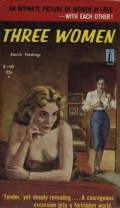 Paula is beautiful but broke, and is planning to marry Phil, who is both wealthy and an excuse for her to escape her alcoholic father. Phil, who has had some thoughts in an entrepreneurial direction, goes to visit his aunt Byrne, who is incidentally a smokin’ hot ‘spinster,’ in the hopes that she will spot him a downpayment. Of course he brings Paula along. After Paula meets Bryne, who is stunning, silk-shirt-wearing, and oozing charm like it’s her job, she starts to stalk her and eventually they fall in love. Of course, Bryne has a dark secret from her past that threatens to destroy everything, which is pretty standard, as these books go.
Paula is beautiful but broke, and is planning to marry Phil, who is both wealthy and an excuse for her to escape her alcoholic father. Phil, who has had some thoughts in an entrepreneurial direction, goes to visit his aunt Byrne, who is incidentally a smokin’ hot ‘spinster,’ in the hopes that she will spot him a downpayment. Of course he brings Paula along. After Paula meets Bryne, who is stunning, silk-shirt-wearing, and oozing charm like it’s her job, she starts to stalk her and eventually they fall in love. Of course, Bryne has a dark secret from her past that threatens to destroy everything, which is pretty standard, as these books go.
There are actually two versions of Three Women: the original from 1958, and a slightly different one from the late 80s, in which Hastings rewrote part of the ending so it was less depressing.
Girls in 3-B, by Valerie Taylor (1959)
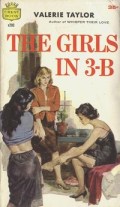 The Girls in 3-B is especially fun because rather than starting off with emotions and insecurities, it skips right to the deep personal struggles and drug hallucinations.
The Girls in 3-B is especially fun because rather than starting off with emotions and insecurities, it skips right to the deep personal struggles and drug hallucinations.
After graduating high school, Pat, Annice, and Barby move to Chicago, move in to an apartment (and, if the cover is any indication, spend a lot of the time in said apartment undressing in front of each other), and deal with narratives of sexism in the workplace, the emphasis on masculinity in alternative culture, and being a lesbian. Analysis of culture: this book has it. There are affairs, there is work place drama, at least one person gets knocked up. The only thing you’d need to turn this book into Mad Men is a few more shots of whisky and a reference to Lucky Strike. While there is less focus on the lesbian story line than elsewhere, the emphasis on watching characters subvert gender norms regardless of how they do it is what makes this book so great. Best of all, the lesbian story line is far less depressing than in, for instance, Spring Fire (though also, most lesbian story lines are less depressing than they are in Spring Fire).
Another Kind of Love, by Paula Christian (1961)
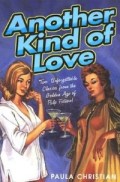 In Another Kind of Love, magazine writer Laura Garraway falls in love with the young starlet Ginny Adams. They kiss and it is magical and stays that way until Laura realizes Ginny will never leave her lover, Saundra, because Saundra can help her be more famous and Laura can’t. Heartbroken, Laura moves to New York, discovers the Village, and, in a pretty surprising twist, gets a happy ending.
In Another Kind of Love, magazine writer Laura Garraway falls in love with the young starlet Ginny Adams. They kiss and it is magical and stays that way until Laura realizes Ginny will never leave her lover, Saundra, because Saundra can help her be more famous and Laura can’t. Heartbroken, Laura moves to New York, discovers the Village, and, in a pretty surprising twist, gets a happy ending.
Happy endings basically never happen in these books, so this is pretty awesome/uplifting.
… Comparatively.
Lesbo Lodge, by Harry Barstead (1963)
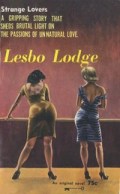 Lesbo Lodge, which is a title that I am not making up, is even worse than a lot of other lesbian pulp because it is, if possible, even trasher. The front cover reads, “A gripping story that sheds brutal light on the passions of unnatural love.” The back cover reads:
Lesbo Lodge, which is a title that I am not making up, is even worse than a lot of other lesbian pulp because it is, if possible, even trasher. The front cover reads, “A gripping story that sheds brutal light on the passions of unnatural love.” The back cover reads:
It was night…
They were alone…
She found herself beckoning urging her to calm the angry fires of her tortured soul.
Something happened to women when they came to love camp, the secluded summer resort with a sordid reputation.
The rest of it involves the idea that lesbians just need to have affairs with men, because it was the early 60s, which means this book is still pretty depressing. But also: hilarious.
Bobby Blanchard, Lesbian Gym Teacher, by Monica Nolan (2010)
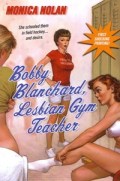 “This past summer it seemed like wedding invitations or engagement announcements arrived almost weekly from the girls Bobby had gotten especially friendly with at Elliott College. Sometimes she got a panicky feeling that the supply of young, nubile girls, which had seemed inexhaustible during her college days when a fresh batch arrived every fall, was inexplicably drying up.”
“This past summer it seemed like wedding invitations or engagement announcements arrived almost weekly from the girls Bobby had gotten especially friendly with at Elliott College. Sometimes she got a panicky feeling that the supply of young, nubile girls, which had seemed inexhaustible during her college days when a fresh batch arrived every fall, was inexplicably drying up.”
Published last year, Bobby Blanchard, Lesbian Gym Teacher has all of the drama and most of the charm of the original pulps, with a lot more puns about which team everyone’s playing for.
After an injury forces her to leave the pro-field hockey world, Bobby gets at job at a girls’ boarding school and enters a world of drama, angst, and more love triangles than season two of The L Word. Plus, who doesn’t want to read about posture, married art mistresses, math teachers with natural eyes for figures, widowed housekeepers, murder investigations, or promising athletes interspersed with make out scenes and more campy references to the books above than I can reasonably reference? (Answer: no one). That said, satire works best when you know what it’s making fun of, so Bobby Blanchard probably shouldn’t be first on your list (Nolan has written two other books in this series and has at least one more coming, so it shouldn’t be last either).


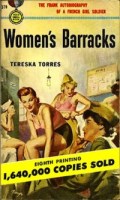

LMAO! i was literally just the other morning looking for somewhere to comment so i can ask for an article /exactly like this/
thank you for reading my mind autostraddle this is the best day ever
I just took a class involving lesbian pulp fiction, so I feel super proud to have read three of these already!
WHERE?! I want to take this class!
Temple University, Philly!
I go to Temple…we have a class about lesbian pulp fiction? and more importantly, WHY HAVE I NOT TAKEN IT?!?!?!?
It was offered as a special course crosslisted under Women’s Studies/GLBT Studies last semester with Dr. Margeaux Cowden. The title was somethng kind of generic, like “GLBT History in America,” but that was actually kind of misleading because we focused exclusively on the medicalization/demedicalization of homosexuality and its treatment in literature. Sort of tracing how it went from being a proclivity, to a sickness, to a mental health problem, to now.
Ah, that makes sense. Since it wasn’t called “Intro to Sexy 50s Lesbian Sex Novels” or whatever, I see why I didn’t know it existed. Seriously though, that sounds like a fascinating class!
Ah, that makes sense. Since it wasn’t called “Sexy 50s Lesbian Sex Novels” or whatever, I can see why I didn’t know it existed. Seriously though, that sounds like a fascinating class!
I’ve posted this reply like three times and it keeps disappearing into the ether…most likely all of them will magically appear at once at some point, so sorry for the possible redundancy.
ANYWAY, that makes sense. Since it wasn’t called “Sexy 50s Lesbian Sex Novels” or whatever, I can see why I didn’t know it existed. Seriously though, that sounds like a fascinating class!
that sounds AWESOME.
For once, I am so disappointed in you, autostraddle. You left out my favorite lesbian pulp fiction series – (Odd Girl Out and the rest of The Beebo Brinker Chronicles)- written in 1957 by Ann Bannon. I’d also like to point out that, unlike most lesbian pulp fiction, The Beebo Brinker Chronicles were written by a queer woman and depicted queerness more completely/accurately than many of the others.
Wikipedia says: “The books’ enduring popularity and impact on lesbian identity has earned her the title “Queen of Lesbian Pulp Fiction”.[1] Bannon was a young housewife trying to address her own issues of sexuality when she was inspired to write her first novel. Her subsequent books featured four characters who reappeared throughout the series, including her eponymous heroine, Beebo Brinker, who came to embody the archetype of a butch lesbian. The majority of her characters mirrored people she knew, but their stories reflected a life she did not feel she was able to live. Despite her traditional upbringing and role in married life, her novels defied conventions for romance stories and depictions of lesbians by addressing complex homosexual relationships.”
;)
Oops, just realized that Odd Girl Out was on the list. Mea culpa. My faith in autostraddle is restored!
Oh Ye of Little Faith
Autostraddle will not let you down
That’s funny. The other day I caught myself kind of skimming covers and reviews of so-called lesbian pulp fiction of the 50s and 60s. I was a little confused because I thought homosexuality didn’t even exist in the minds of Americans back then. From the reviews I read, it seems like the stories usually have some sort of reinforcing message where the lesbians are predatory, lose their minds, or end up with men happily ever after. And apparently the stories themselves aren’t quite as salacious as the covers make them seem, although there is a lot of apparent sleeping around, just not described explicitly. I don’t think I’d really want to read one, but I am fascinated by how these books were somehow acceptable and how they fit into the larger context of how homosexuality was treated during those eras. Some of the covers are just awesome. I’d like to get one on canvas for my wall!
According to Megan Rose Gedris, writer of one of my favourite comics, lesbians, pirates and aliens were the three most common themes in 50s pulp novels. So, erm.. I can only surmise that in the 50s they thought lesbians were creatures not dissimilar to aliens ie. not real.
I noticed they were referred to as a “third sex” very often, which is an, erm, interesting way to look at it, I suppose.
Dude! I love Megan Rose Gedris! Have you read Yu+Me: dream? I haven’t really read a lot of the lesbian pirate one.
I have read half of yu+me but then schoolwork got in the way. I plan on reading the rest when I get some holidays because it’s so addictive once I start reading I can’t stop. Lesbian Pirates is awesome.
Yeah, the covers were meant to draw in men and secretly queer women. Books that didn’t have any lesbian content in them at all started putting these kinds of images on them to trick consumers. Initially the books flew under the radar but once they gained popularity, they were justified by claiming they were helping curb the “hidden lesbian contagion” or as a “study of society’s greatest curse: homosexuality.” The thinking was no harm could be meant from books that studied the “contagion” scientifically in an effort to eradicate it.
That’s kind of hilarious that they tried to trick people.
I wonder if this is where the whole straight men obsessed with lesbians thing started.
The whole eradication plan obviously didn’t work. If anything you’d think reading these books would make people realise they were homos. Sort of like the ‘Shane Effect’ of the 50s.
Forbidden Love: The Unashamed Stories of Lesbian Lives. It’s a documentary on lesbian pulp fiction. I think I saw this on LOGO a long time ago; I remember it was the first time I had heard of all this.
So is the phrase “Dip me in honey and feed me to the lesbians” something from a lesbian pulp fiction novel? because I feel like it would be.
Claire, probably not now! What with the vegan/queer crossover, it’d be “roll me in nooch and feed me to the lesbians!”
FYI: I’ll probably use this in the sequel to my last novel, Don’t Bang the Barista! (queer pulp fiction), so thanks for the inspiration!
I have been trying to get my hands on some lesbian pulp fiction for a writing project, and damned if I can’t find any. I can find the re-released versions, but no originals. Although I do have The Grapevine by Jess Stearn, which is supposed to be a nonfiction “study” of lesbians. Hilarious/terrible.
So that’s where that comes from! My girlfriend’s address book has the Lesbo Lodge image on it’s cover. Not the title, just the image. Well, now I wanna read it.
oooh I hope these come on kindle though they probably dooon’t
Wow! Today, I picked up two lesbian pulp novels at the used book store (the only lesbian fiction they have in the whole place…sigh), and one is on this list! Yay!
This is scary.
I knew nothing about this earlier today.
Then I stumbled upon this website: http://www.strangesisters.com/a-z/images/
and spent a whole hour looking through all the lesbian pulp fiction cover art. And then I just had to go and look all the books and authors up.
You people have been reading my mind, and this isn’t the first time.
Now I must go check in my browser’s history thingy if I can find what made me look for these in the first place, even though I’d rather think it was AT (autostraddle-telepathy).
Concerning the Beebo Brinker Chronicles. The 5th book that was written, Beebo Brinker, actually takes place first in terms of chronological narrative. I also think it is, oddly enough, the least well written. I recommend reading that one first. It makes the order far more satisfying. Also there are twists and turns that may put some off(I know friends who almost checked out after certain things happen in Odd Girl Out and Women in the Shadows). I recommend sticking with it. The conclusion is extremely satisfying. Also weird is that the Naiad Press compilation left out Journey to a Woman (which is the best book and the one that makes everything pay off). Probably some sort of copyright problem.
Here’s the order I would use when reading.
1. Beebo Brinker
2. Odd Girl Out
3. I Am A Woman
4. Women in the Shadows
5. Journey to a Woman
I just joined a Seattle gay lady bookclub and next month’s topic is Beebo Brinker. Two books from the series are headed my way now, thanks to the amazingness that is Powell’s! Now if I could just get a job everything would feel right again. Good thing I can use all this spare time reading pulp, I mean, writing cover letters.
Great summaries! Maybe I’ll just read each one and stop before the depressing ending…
Maybe you could write your own ‘new and improved’ ending!
This article makes me extremely disappointed in my local library. I could not find one title on this list, and only one of the author’s mentioned shows up on the search (In a book called “The L Life,” which I’m going to check out as it has a huge picture of Jane Lynch on the cover..)
Soo, it looks like I’m off to amazon dot com.
Can someone pass on the link that will take me to the “AUTOSTRADDLE BENEFITS FROM YOU BEING A READER/BUYING BOOKS AND THINGS” site?
Thanks!
It’s the first link on this page: http://www.autostraddle.com/support-autostraddle/
Happy reading!
Lesbian pulp fiction, yo: way to find Philip Larkin in some unexpected places. http://en.wikipedia.org/wiki/Brunette_Coleman. Gymslips, hockey sticks and sapphic titillation. I’ve hunted these novels out just for laffs, but not read yet…slightly disillusioned by the ‘gay girl in damascus’-ish echoes. Even though I know I should stop being so sentimental about biography and separate it from the work blahblah.
Besides the phrase “third sex” the term “twilight” was often used- “world of twilight love”, “the love that dwells in twilight”. Paula Christian’s “The Edge of Twilight” was one of the first pulps to have a positive ending. You can get a hold of original collectibles (not reproductions) at lavenderpulp.com
I live in the middle of nowhere and my used bookstore doesn’t keep anything more than 5 years old in stock. How can I get some of these. I found just a few in the Kindle Store and they were awesome. Any sites that sell this stuff specifically?
Good morning! I encourage you to keep reading and promoting these novels. But please don’t call them pulp fiction. Pulp fiction doesn’t mean “lurid.” It refers only to the cheap, untrimmed pulpwood paper on which those MAGAZINES were printed on. That’s how pulps got the name. You are referencing paperback books here. Collectors already gave them a name: paperback originals. Paperback books were not published on pulp. There was never any Lesbianism in them. In fact, paperbacks helped the pulps go extinct right around the same time these books got published. Logically, they can be the same thing.
Paperbacks exist to this day. Check the bestseller list. Compare one of these books you call pulp to a current paperback book — take one of each in your hands right now. You will see, and feel, that they are exactly the same. A pulp author produced a novel every month. Few, if any, of the authors you are discussing published a novel a month. Paperbacks do not have any such schedule.
Let me guess: you looked it up and a dictionary says pulp might include paperback books. That is a misconception. I am sure you are aware of many popular misconceptions: people think spiders are insects or the tomato is a vegetable, for example. These are all misconceptions. If the novels you are discussing were pulps, then what those fiction magazines from the 1930s that were printed on pulp?
You call certain books “pulp” for, well, what reason? There is no reason. You’re just parroting what others have told you. The cover? Ridiculous. Look around and you will find books from the same era with the same kind of lurid covers, only they are sometimes classics of literature or non-fiction. Good Lord! How can those be pulp? You don’t judge a book by its cover. We got a current writer up here in Seattle who calls his stuff pulp and it just isn’t. Pulps were aimed at young people. His stuff and Lesbian novels are not for kids. I know because I work with kids.
The best part of this comment is:
“I am sure you are aware of many popular misconceptions: people think spiders are insects or the tomato is a vegetable, for example.”
Since you CLEARLY don’t know what “pulp fiction” means, you probably also don’t know what a “misconception” is.
‘The best part of this comment is:
“I am sure you are aware of many popular misconceptions: people think spiders are insects or the tomato is a vegetable, for example.”
Since you CLEARLY don’t know what “pulp fiction” means, you probably also don’t know what a “misconception” is.’
You think THAT is the best part, an example that I used to illustrate this for you? Not the valid points I made? I could have given you many more and you could have shot them all down. That wouldn’t change my point. Read my original comment again my analogies, then. My points remain.
Well, this was just odd.
Merriam-Webster’s 4th definition of pulp is “a magazine or book printed on cheap paper (as newsprint) and often dealing with sensational material; also : sensational or tabloid writing —often used attributively “. Oh but wait, I see that you question the validity of dictionaries above.
Look, “pulp fiction” is widely accepted as shorthand for lurid or “sensational” fiction. It’s not controversial. It’s standard. And you are a person of very eclectic principles!
‘..a magazine or book printed on cheap paper (as newsprint) and often dealing with sensational material; also : sensational or tabloid writing
Look, “pulp fiction” is widely accepted as shorthand for lurid or “sensational” fiction.’
That’s just my point; you are being mislead. People widely accept that spiders are insects, too. But they aren’t. Half right isn’t right. Pulp was not lurid, sensational or tabloid! Can you show me that it was? The biggest genre in it was tame romance. You aren’t up on your pulp.
Paperback books, including lesbian pulp fiction, were also printed on cheap pulp paper, as discussed in Katherine V. Forrest’s Lesbian Pulp Fiction: The Sexually Intrepid World of Lesbian Paperback Novels 1950-1965, the New Yorker, and elsewhere on this website.
Again, you’re being mislead and parroting what you’ve been told. If they were from 1960-65, they weren’t “pulp.” They were paperback books. Paperback books are not pulp.
But like you get that just because they weren’t literally printed on what was originally called “pulp” they are still today be called pulp fiction, right? Language evolves over time. For instance, the word ‘gay’ didn’t used to mean homosexual…
Now let’s let poor Carolyn go get married in peace! :-P
*still called pulp fiction today
‘Katherine V. Forrest’s Lesbian Pulp Fiction: The Sexually Intrepid World of Lesbian Paperback Novels’
How can they be pulp and paperback at the same time? The answer is they aren’t pulp at all.
I’m not talking about what “gay” meant in the past. There’s no logical reason to call those books “pulp.” It’s just a conceit.
‘Katherine V. Forrest’s Lesbian Pulp Fiction: The Sexually Intrepid World of Lesbian Paperback Novels’
How can they be pulp and paperback at the same time? The answer is they aren’t pulp at all.
aren’t tomatoes both a vegetable and a fruit? ¯\_(ツ)_/¯
So, does that make tomato pulp the equivalent of bi/pan pulp fiction?
I read a lesbian pulp book as a teen. My first exposure to lesbian anything as a matter of fact. Lol. Anyways, the book was called Lispstick against Lipstick. I would love to have that read again. I have no idea who the author was, sorry.
I see I’ve found my summer reading list.
Pingback: The Ultimate Lesbian Books List; 75 Lesbian Stories to Read ASAP – Lesbian Chat Room